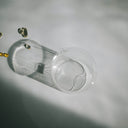Hair loss can be a deeply personal journey, especially for women.
It’s not just about the strands of hair you lose—it’s about the confidence and self-assurance that seem to slip away with them.
Thankfully, a solution exists that’s both natural-looking and long-lasting: hair transplants for women.
If you’ve been struggling with thinning hair or bald spots, this article will help you understand how hair transplants can bring back more than just your hair.
Table of content
What is a hair transplant for women?
A hair transplant for women is a procedure where hair follicles are taken from one part of the scalp and transplanted to thinning or balding areas. It’s an effective, long-lasting solution for female hair loss.
Hair transplants are a game-changer for women dealing with hair thinning or bald spots.
Unlike temporary options like wigs or extensions, a hair transplant involves taking healthy hair follicles from areas of the scalp where hair still grows (commonly the back or sides of the head) and carefully transplanting them to areas that need more density.
This surgical procedure is popular for treating conditions like female pattern baldness, restoring receding hairlines, and even creating fuller eyebrows.
The results look natural because the transplanted hair continues to grow just like the rest of your hair.
While it doesn’t cure every type of hair loss, it’s a long-term solution for women facing permanent thinning.
As your leading source for hair health information over the past 4 years, we never compromise on accuracy. When it comes to your health, you deserve information you can truly rely on - and earning your trust is our top priority.
Here's how Scandinavian Biolabs ensures every piece of content meets the highest standards of accuracy and integrity:
- Credentialed Experts: Our reviewers are actively practicing doctors and medical researchers
- Stringent Reviews: Content undergoes rigorous editing by subject specialists and review by a practicing doctor.
- Evidence-Based: We rely on well-established research from trusted scientific sources like peer-reviewed journals and health authorities.
- Full Transparency: Our editorial standards, writer credentials, reviewer credentials, correction process, and funding are all publicly documented.
- Independent Voice: While we do promote products, we operate in a vacuum to business operations. Our main goal is just an unwavering commitment to providing medically-sound guidance.
You can count on Scandinavian Biolabs to consistently deliver the trustworthy health information you deserve. Read our Editorial Standards.
What causes hair loss in women?

Hair loss in women can happen for many reasons. It’s important to identify the root cause before considering treatments like a hair transplant.
- Androgenetic alopecia (female pattern baldness)
- Hormonal changes (e.g., menopause, pregnancy)
- Stress and lifestyle factors
- Medical conditions (e.g., thyroid issues, autoimmune diseases)
- Traction alopecia from tight hairstyles
- Nutritional deficiencies
Who is eligible for a hair transplant?
Not all women experiencing hair loss are candidates for a hair transplant. The type and severity of hair loss play a big role in determining eligibility.
- Women with permanent hair loss, such as androgenetic alopecia.
- Those with sufficient donor hair in areas like the back or sides of the scalp.
- Individuals in good overall health, without conditions that could affect healing.
- Women looking to restore areas where hair growth is no longer possible (e.g., hairline lowering or scar repair).
Temporary hair loss conditions, such as alopecia areata, are usually not treated with transplants as hair may regrow naturally.
How does the procedure work?

A hair transplant involves moving hair follicles from one part of the scalp to another. Here’s a step-by-step breakdown of how it works:
Consultation and planning
During the initial consultation, your surgeon will assess your hair loss pattern, check the donor area, and create a personalized treatment plan.
This step is crucial to determine the number of grafts required and the areas to target.
Preparation and local anesthesia
Before surgery, the donor and recipient areas are cleaned and prepared. A local anesthetic is applied to numb the scalp, ensuring a pain-free experience.
You might feel a slight prick, but the discomfort is minimal.
Follicle extraction
Using the FUE (Follicular Unit Extraction) method, the surgeon carefully removes individual hair follicles from the donor area.
These follicles are extracted in tiny clusters, minimizing scarring and preserving a natural appearance.
Recipient site creation
Next, tiny incisions are made in the recipient area to prepare for follicle implantation.
The surgeon ensures the angle and direction of these incisions match the natural growth pattern of your hair.
Implantation
The extracted follicles are meticulously placed into the prepared sites one by one. This is a time-consuming process that requires precision to achieve a seamless and natural result.
Post-procedure care
Once the surgery is complete, your surgeon will provide detailed aftercare instructions to promote healing and encourage healthy hair growth. Recovery is typically smooth, with minimal downtime.
What are the benefits of hair transplants for women?
A hair transplant can transform more than just your appearance. Here are some of the benefits:
- Natural-looking results: The transplanted hair grows just like the rest of your hair, blending seamlessly.
- Long-lasting solution: Unlike temporary fixes, transplanted hair is permanent.
- Boosts confidence: Many women feel a renewed sense of self-esteem after restoring their hair.
- Minimally invasive: Techniques like FUE involve tiny incisions, leading to faster recovery and less scarring.
- Versatility: Suitable for treating bald spots, thinning areas, hairline lowering, and even eyebrow restoration.
Each of these benefits not only improves your appearance but also enhances your quality of life, allowing you to feel more like yourself again.
What is the recovery process and aftercare for hair transplants?
Recovering from a hair transplant is usually straightforward, but it’s important to follow the aftercare instructions for the best results. Most women find they can return to their regular routine within a week, but the healing process continues over several months as the transplanted hair begins to grow.
In the first few days, you might notice some swelling or redness around the treated areas. This is completely normal and should fade quickly.
Keeping your scalp clean and hydrated is key during this stage to prevent infection and reduce scabbing.
- Avoid washing your hair for the first 48 hours.
- Use a gentle shampoo and lukewarm water when washing your hair in the first week.
- Avoid direct sun exposure on your scalp for at least two weeks.
- Steer clear of tight hairstyles or hair treatments (like coloring) for about a month.
It’s common for the transplanted hair to shed within the first two to four weeks—don’t worry!
This is a normal part of the process. New, healthy hair will start growing in its place after about three months, with full results visible in 9–12 months.
How much do hair transplants for women cost?
The cost of a hair transplant for women in the UK typically ranges from £3,000 to £7,000, depending on the severity of hair loss and the number of grafts required.
The exact price of a hair transplant depends on factors like the size of the treatment area, the technique used, and the clinic’s location. Smaller areas, like an eyebrow transplant, will naturally cost less than treating larger areas of thinning hair.
Some clinics also offer payment plans, making this investment in your confidence more manageable.
Keep in mind that a hair transplant is a long-term solution, so while it may seem costly upfront, it can save you from spending repeatedly on temporary treatments.
A better non-invasive alternative to a hair transplant

If surgery isn’t your first choice, there are effective non-invasive options for addressing hair thinning.
One standout solution is the Bio-Pilixin® Activation Serum, developed by experts to support hair growth and reduce thinning.
This serum uses plant growth factors created with stem cell technology to nurture hair follicles and encourage healthy hair growth. It works by improving blood flow to the scalp and supplying essential nutrients directly to the hair roots.
The serum is clinically tested, drug-free, and safe for daily use.
According to clinical studies, 77% of users noticed reduced hair loss after just 45 days, and 73% experienced a measurable increase in hair density after 150 days.
Plus, the satisfaction rate is a strong 93%!
What’s even better? Many users report seeing less hair in the shower after just a few weeks.
This makes it a fantastic option for those who want to tackle hair loss without committing to surgery. With a 150-day money-back guarantee, it’s also a low-risk way to try something new.
Conclusion
Hair transplants for women can be a life-changing solution for those experiencing permanent hair loss.
From addressing female pattern baldness to restoring thinning areas and even creating fuller eyebrows, this procedure offers natural-looking and lasting results.
While the cost may seem significant, the long-term benefits make it a worthwhile investment.
For those looking for a non-surgical option, the Bio-Pilixin® Activation Serum is an excellent alternative.
With proven clinical results and a commitment to nurturing healthy hair, it’s a gentle yet effective way to address thinning and hair loss.
Take the next step today—try Bio-Pilixin® Serum and see the difference for yourself. Your journey to healthier, fuller hair starts here!
FAQs
Does a hair transplant hurt?
Not really! The procedure is done under local anesthesia, so you might feel a slight prick at first, but the rest of the surgery is painless. Some soreness or tightness may occur during recovery, but it’s manageable with over-the-counter pain relief.
How long does it take to see results from a hair transplant?
Initial growth begins around 2–3 months post-surgery, but full results can take up to 9–12 months. The transplanted hair will shed before regrowth, so don’t panic—it’s part of the process.
Are hair transplants permanent?
Yes, the transplanted hair follicles are taken from areas resistant to hair loss (like the back of the head) and will continue to grow naturally in the new location. However, future thinning in other areas may require additional treatments.
Can women with temporary hair loss get a hair transplant?
No, hair transplants are typically for permanent hair loss, such as androgenetic alopecia. Conditions like alopecia areata or telogen effluvium are temporary and usually don’t require surgery, as hair often grows back naturally.
How much downtime is needed after a hair transplant?
Most women can return to light activities within 2–3 days and resume their normal routines in about a week. However, avoiding strenuous activities and direct sun exposure for a couple of weeks is recommended.
Can I dye my hair after a hair transplant?
Yes, but it’s best to wait at least 4–6 weeks to allow your scalp to heal fully. Always consult with your surgeon before applying any chemicals to your hair or scalp.
References:





